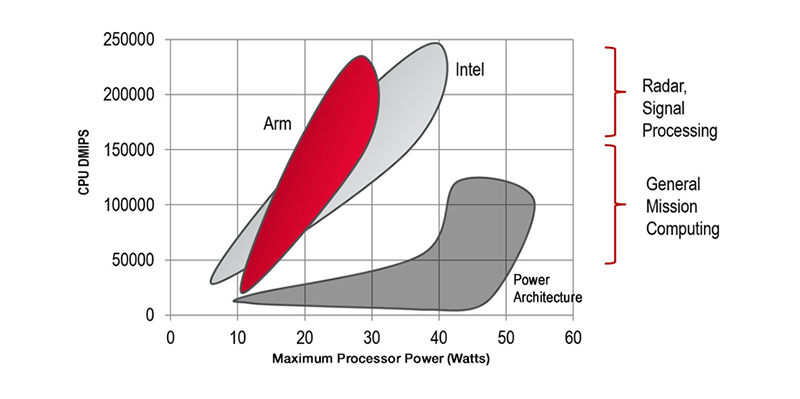
Published in SAE International
Co-authored by: Geoffrey Waters, Senior Systems Engineer, NXP Semiconductors
In recent years, Arm processors have made a quiet, understated entry into the aerospace and defense market. With a well-established reputation in commercial markets for bringing high performance to low-power mobile devices, such as smartphones, tablets, and wearables, it’s no surprise that Arm’s potential was recognized in an industry where size, weight, and power (SWaP) constraints heavily influence technology selection.
Arm, once an acronym for Advanced RISC Machine, employs reduced instruction set computing (RISC) to decrease cycles per instruction, which in turn lowers the processor’s power consumption and dissipates less heat. Consequently, Arm architectures deliver an unparalleled power-to-performance ratio to meet the requirements for many aerospace and defense applications.
Even so, Arm chips are far from ubiquitous in the mil-aero industry, a world that has been long dominated by Intel and Power Architecture processing units. These incumbents offer rugged processors that are optimized for maximum performance, have been implemented in boards with a minimal physical footprint, and have been proven to maintain reliability in harsh environments. What’s more, because Intel and Power Architecture processors have powered many avionics systems to date, a variety of these chips provide the service history and design artifacts required for DO-254 certification.

Processor architecture performance and power consumption comparison
In recent years, ARM processors have made a quiet, understated entry into the aerospace and defense market. With a well-established reputation in commercial markets for bringing high performance to low-power mobile devices, such as smartphones, tablets, and wearables, it’s no surprise that ARM’s potential was recognized in an industry where size, weight, and power (SWaP) constraints heavily influence technology selection.
A previous white paper explored in-depth why Arm processors are ideal for aerospace, defense, and rugged embedded applications. But, with a SWaP-friendly nature and proven history in commercial technology (Arm Limited reports 50 billion chips were shipped from 2013 to 20172), do Arm processors have what it takes to meet the highest DO-254 requirements?
Filling the Power Architecture Void
The company Arm, unlike Intel, does not make or sell Arm processors, but owns the architecture intellectual property and licenses it to manufacturers such as NXP Semiconductors, NVIDIA, Apple3, Qualcomm, and Samsung. Similarly, the term “Power Architecture” describes a processor architecture as opposed to a brand of product. Power Architecture processors have been most commonly produced by NXP (formerly Freescale) and IBM.
Power Architecture processors also use RISC to provide low-power computing, and those manufactured by NXP have been proven in a wide range of DO-254 safety-certifiable applications, both commercial aerospace and defense, often to the highest design assurance level (DAL). But with no NXP Power Architecture devices planned for introduction after the currently released QorIQ T-series of products, this landscape is set to change in the future.
Read the full article here.